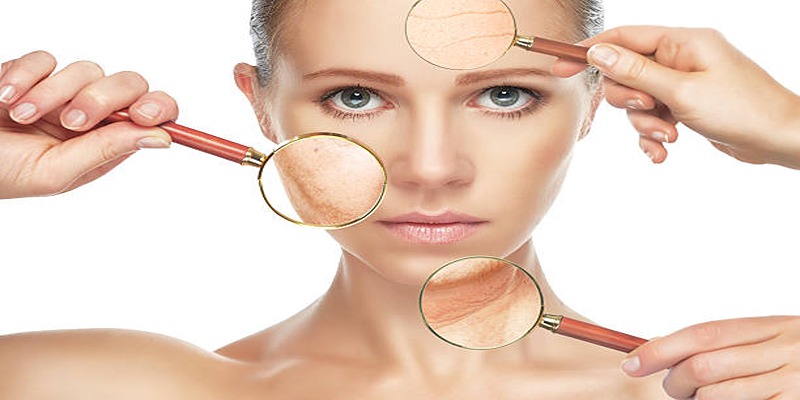Owning both dry and oily regions on your face makes it sometimes feel like managing two different skin types at once. There are areas that get dry, while others receive adequate moisture that may cause oils on your skin to come through. This can make the identification of the right skin care products rather difficult. But dont worry! This guide is here to help you find a simple routine suitable for all skin areas on your face. Next, well provide general dermatologic advice to maintain your skin well, hydrated and healthy. You will find out which products are most effective to use and how to look after the dry areas and the oilier areas of your skin.
Understanding Combination Skin

Combination skin typically has a mix of both dry and oily areas on the face. The T-zone, which includes your forehead, nose, and chin, tends to be oilier than the rest of your face. On the other hand, your cheeks may feel drier and more prone to flaking. Additionally, you may also have enlarged pores in your T-zone area due to excess sebum production.
Understanding your skin type is crucial because it helps you choose products that work best for your skins unique needs. If you have combination skin, its essential to use products that address both the dry and oily areas without aggravating either.
Causes of Combination Skin
The cause of combination skin is largely genetic, but other external factors can also contribute to its development. Some possible causes include:
- Hormonal changes: Fluctuations in hormones, especially during puberty or menopause, can lead to combination skin.
- Weather: Changes in weather or climate can affect your skin's oil production and moisture levels.
- Improper skincare routine: Using harsh products or over-cleansing the face can strip away natural oils and make some areas drier while causing excessive oil production in others.
Skincare for Combination Skin
When it comes to taking care of combination skin, finding a balance between hydration and controlling excess oil is key. Here are a few essential steps to include in your skincare routine:
Cleansing
Start your skincare routine with a gentle cleanser that effectively removes dirt, oil, and makeup without stripping away essential moisture. Look for a pH-balanced cleanser that is suitable for all skin types, including combination skin.
Exfoliation
Exfoliating regularly can help remove dead skin cells and unclog pores, preventing acne breakouts and keeping the T-zone area less oily. However, be careful not to over-exfoliate as it can dry out the drier areas of your face.
Moisturizing
Moisturizing is crucial for maintaining healthy-looking skin. For combination skin, look for lightweight moisturizers that wont clog pores and cause breakouts. You can also use different moisturizers for different areas of your face, such as a thicker cream for the dry areas and a gel-based formula for the T-zone.
Sun Protection
Sunscreen is crucial for all skin types, including combination skin. Look for non-comedogenic formulas that wont clog pores, and choose an SPF of at least 30 to protect your skin from UV damage.
Targeted Treatments
For specific skincare concerns, such as acne or anti-aging, consider incorporating targeted treatments into your routine. Look for products with active ingredients like salicylic acid or retinol that can address both oily and dry areas.
Product Recommendations
- Cleanser: Cetaphil Gentle Skin Cleanser
- Exfoliator: Paulas Choice Skin Perfecting 2% BHA Liquid Exfoliant
- Moisturizer: Neutrogena Hydro Boost Gel Cream
- Sunscreen: La Roche-Posay Anthelios Clear Skin Sunscreen SPF 60
- Targeted Treatment: The Ordinary Salicylic Acid 2% Solution
Tips for Managing Combination Skin

Here are a few additional tips to help you manage combination skin and maintain a healthy balance:
- Use oil-based products sparingly: If you have combination skin, chances are you already have excess oil in your T-zone. Using oil-based products can further contribute to the shine in this area. Instead, opt for water-based or gel formulas that wont clog pores.
- Pay attention to ingredients: Avoid using products with harsh ingredients such as fragrance, which can strip your skin of moisture and cause irritation. Look for gentle, non-irritating ingredients like hyaluronic acid and niacinamide that can benefit both dry and oily areas of your face.
- Don't forget to moisturize the dry areas: Just because some parts of your face are oily doesn't mean you should skip moisturizing those areas altogether. Proper hydration is essential for maintaining healthy skin, so make sure to apply a lightweight moisturizer to the dry areas of your face as well.
- Don't overwash: Washing your face too frequently can strip away natural oils and cause excessive dryness. Stick to cleansing twice a day, morning and night, to maintain a healthy balance.
Foods that benefit combination skin
The food you eat can also have an impact on your skin's overall health and appearance. Incorporating these foods into your diet can help maintain a healthy balance for combination skin:
- Avocados: Avocados are rich in healthy fats that can nourish dry areas of the face.
- Salmon: Salmon is a great source of omega-3 fatty acids, which can help reduce inflammation in both dry and oily areas of the face.
- Leafy greens: Leafy greens like spinach, kale, and collard greens are packed with vitamins and minerals that promote healthy skin.
Conclusion
Combination skin may seem tricky to manage, but with the right skincare routine and products, you can achieve a healthy balance and maintain radiant skin. Remember to pay attention to your skin's needs and make adjustments to your routine as necessary. With proper care and nourishment, you can have the best of both worlds smooth, hydrated cheeks and a shine-free T-zone! Keep experimenting with different products until you find what works best for your unique combination skin.











